Trincomalee glistens
Script and pictures Sachitra Mahendra in Trincomalee
Sighting the blissful environs of Trincomalee after the end of a
decades-old war was moving on a Tuesday morning. The war-torn background
that once was has now changed to a heavy influx with carefree masses
thronging to see the beauty of the sandy beaches and feel the golden
sand.
Many sources such as the Internet and English reference guides link
the origin of the city with a Hindu God called Koneswaran.
However P. L. Sirisena, who has been posted in Trincomalee for a long
time, has authored Siri Gonamalaya hevath Tirikunamalaya (Dayawansa
Jayakody publication; Rs 320), a book that brings out a different fact.
Since the mountain looks like a sambhur (gona), its head and two ears,
it has been called Siri Gona Kanda. It is withal called Gona Karna,
Gonagala, Gonagam patuna and so on.
P. L. de Silva has written the book - probably the only comprehensive
book on Trinco, to this day - in beautiful yet academic Sinhala. This is
a book someone should read before setting off to the Eastern border of
Sri Lanka.
The long and empty stretch of Anuradhapura-Trincomalee road may give
you the creeps at times.
The road is shiny under the scorching sun. Unless you are a foreigner
fond of getting a tan, you may not like the idea of getting down.
Some cadjan hut fences were embellished with palm leaves, giving you
the feel of being in Jaffna, which is still miles away. The road remains
almost deserted save for ubiquitous checkpoints and NGO vehicles with
ironical 'no gun' stickers buzzing to and fro.
Checkpoint officers do smile and are very cooperative welcoming the
guests to the city. All these top off a scarred city that was once
glorious.
Unattended shrine rooms, roofless houses, cows grazing all alone,
dust spewing roads, burnt wood, cracked rocks reign the area.
The city of Trincomalee has the reputation mainly for its large
harbour. It houses major naval bases and an Air Force base too.
Read the sky deep into the night. Rise early to witness the daybreak
sneak over the horizons with its large golden plate - sunrise, that is -
and saffron rays that ring the sun add yet another blissful moment.
|
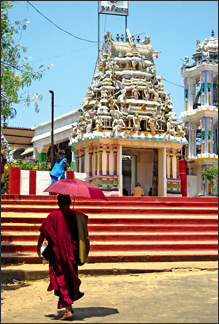
Inter-religious harmony: a monk visiting the Kovil |
|
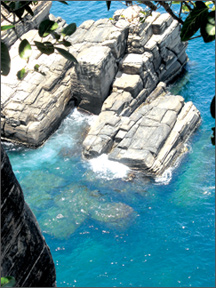
Photographing the Lovers’ Leap in a perfect proper angle turns
out to be the hardest task under harsh sun that bears down on
the Koneswaram Kovil’s sand at daytime. |
Koneswaram Kovil
|
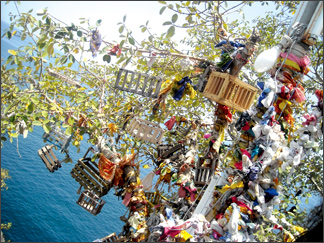
Hindu mothers make
miniature cradles and
hang on this tree in the Kovil as an offering if their wishes
for childbirth
was fulfilled |
The kovil is said to have existed even before the arrival of Prince
Vijaya. The history has it that Indian Pallava, Chola and Pandya kings
had contributed to the upbringing of this religious site.
The Koneswaram temple is believed to have been a major religious
shrine since before the arrival of Prince Vijaya 2500 years ago. The
internet encyclopedia Wikipedia says this shrine was demolished by the
Buddhist King Mahasena, who 'built a Buddhist temple and Dagoba in its
place', but cites no reference to support the fact. Located close by is
the Swami Rock, also dubbed as Lovers' Leap, which has adorned the
folklore of the city.
As one folktale reveals, two devoted lovers had made a leap from atop
the mountain, but was rescued by a Swami. 'Sri Lanka Insights Guide'
offers another story:
"... on account of a Dutch official's daughter, Francina van Reede,
who threw herself off the rock after watching her unfaithful husband
desert her by sea. Although her suicidal attempt was unsuccessful, and
she went on to marry for a second time eight years after, her father
erected a pillar to mark the incident."
Hot water springs
|
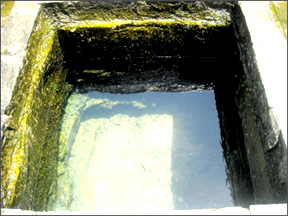
Hot water well |
Kal and niya mean stone and land respectively in Tamil. The area is
famous for its hot water wells. Each well has a high wall with a
rectangular corral. Every well is believed to have a different
temperature, with one well overly hot. Still and all it seems more a
faith than reality.
Water gives a luxurious warm sensation even at daytime. The area is
now under the control of Mari Amman Kovil. The
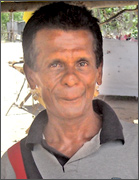 |
“Only when
the ceasefire was in force, everyone was allowed to use these
wells. However they were heavily taxed”
- Nimalsiri |
springs have separate places for changing and no footwear is allowed.
Nimalsiri, who sells victuals in a nearby stall, recalled his
experiences - not exactly soft - when the wells were under the control
of the LTTE.
"Only when the ceasefire was in force, everyone was allowed to use
these wells. However they were heavily taxed."
Nimalsiri lives in Mihindupura, a Sinhalese-dominant village. During
the wartime the Sinhalese had tipped off the Forces about the Tiger
activities.
"We saw how things happened. Many NGOs were behind these activities.
There was a bank manager who masterminded hartals. We tipped off about
him and he was arrested. We were cooperative with the army wherever
possible. We were given weapons for our security as well."
|
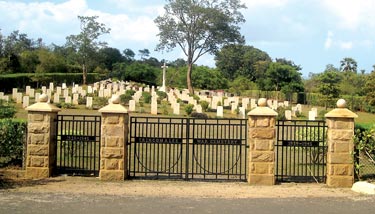
The facade of Trincomalee War Memorial |
Grandeur of a war-time cemetery
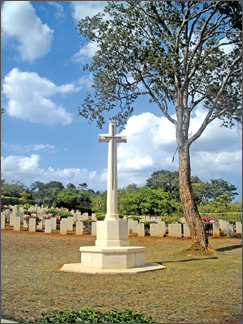 During
the World War II Ceylon was a main naval Air Force base against Japan.
The British used the eastern border for the jungle warfare training. The
British who died in the war were honoured on six cemeteries: four in
Colombo, one each in Kandy and Trincomalee. Trincomalee cemetery's
grandeur is second only to that of Kandy, indicating the British's flair
for lush sense of landscape. It doesn't scare the visitors, as it is
supposed to be. The cemetery is located outside Trinco, on Nilaveli
road. The cemetery is looked after by a soft spoken watcher who is
willing to give any information about the history of the cemetery. Every
visitor is requested to write their comments on the guest book before
leaving the cemetery. During
the World War II Ceylon was a main naval Air Force base against Japan.
The British used the eastern border for the jungle warfare training. The
British who died in the war were honoured on six cemeteries: four in
Colombo, one each in Kandy and Trincomalee. Trincomalee cemetery's
grandeur is second only to that of Kandy, indicating the British's flair
for lush sense of landscape. It doesn't scare the visitors, as it is
supposed to be. The cemetery is located outside Trinco, on Nilaveli
road. The cemetery is looked after by a soft spoken watcher who is
willing to give any information about the history of the cemetery. Every
visitor is requested to write their comments on the guest book before
leaving the cemetery.
Epigraphs: Though far away, you will live forever in our tenderest
memories. There is a land of the living and a land of the dead; And the
bridge is love. Their name liveth for evermore
|
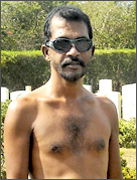
Watcher of Trinco War Memorial |
Keep your beach clean
 Nilaveli
- the 'blue waters', if loosely translated into English - doesn't let
you touch the waters, if you are a nature admirer. You would be more
fond of looking far ahead and feel the joy of the glistening tide and
the waves, too arresting to forget. Turquoise waves jostle into each
other with you basking in nature's wonder. Lay your bare feet on the
sunny golden sand and fix your thoughts: serenity steals your mood for a
while. Nilaveli
- the 'blue waters', if loosely translated into English - doesn't let
you touch the waters, if you are a nature admirer. You would be more
fond of looking far ahead and feel the joy of the glistening tide and
the waves, too arresting to forget. Turquoise waves jostle into each
other with you basking in nature's wonder. Lay your bare feet on the
sunny golden sand and fix your thoughts: serenity steals your mood for a
while.
Sri Lanka is blessed with such beautiful beach scenery. Many seem
almost virgin, compared with numerous foreign beaches. Foreigners are
keen about our beaches because of its cleanliness. Yet it doesn't seem
so in the eastern beaches. Human waste have now fouled them. All the
beaches have become the dooryards of mushrooming tourist hotels. Many
hotel structures do not have any aesthetic sense either; their owners do
not seem to think about nature too. All the waste of these luxurious
hotels are drained to the beach, drawing more crows than tourists.
|



